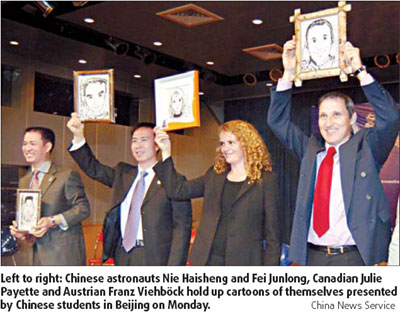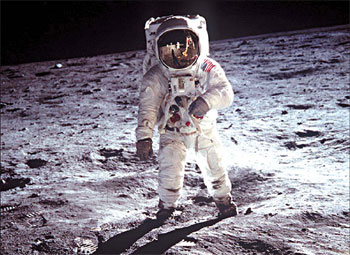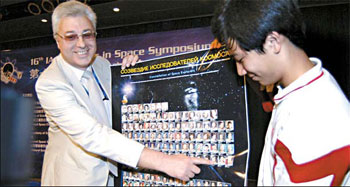Taking the next step
US astronaut Neil Armstrong descended from landing craft Eagle on July 20, 1969, and his next action captivated the world.
"That's one small step for man, one giant leap for mankind."
US astronaut Buzz Aldrin walks on the Moon surface on July 20, 1969. He was the second person ever to set foot on the Moon, following Neil Armstrong. Courtesy of NASA |
With those immortal words, the first man to set foot on the Moon sparked the imagination of generations to come.
The exciting scene on this strange satellite, rotating at an average distance of 380,000 kilometers away from the Earth, quickly spread through the world, igniting wild dreams of humans one day living and working on the Moon.
While the quest to explore space has continued since, lunar expedition is not as easy as the science fiction writers would have us believe. Between 1969 and 1972, the United States sent 12 astronauts to the Moon, and remains the only country to have successfully done so.
Today marks the conclusion of the 16th Human in Space Symposium of the International Academy of Astronautics. Held in Beijing, the weeklong event hosted 10 astronauts from Russia, US, Canada, France, Austria and China. They discussed obstacles for exploration, shared visions of future Moon tourism and even touched on the prospect of a trip to Mars.
The symposium echoes the rekindling of an international Moon fever in recent years, with new plans for space missions announced by several countries.
China's ambitious Chang'e moon exploration program was launched in 2003. In the US last year, the National Aeronautics and Space Administration announced its astronauts would return to the Moon and build a base there by 2020. Russia, Japan and India all publicized similar strategies for travel to the Moon.
Yet, what are the challenges ahead for astronauts and astronautic scientists? What is the future for life on the Moon? How does one best go about becoming a qualified moon astronaut?
This week's event provided a rare platform to gauge opinions on these important issues from the ones at the forefront of the modern space frontier -- the astronauts. Here are some of their thoughts.
Yang Liwei, China
(The first Chinese astronaut, Yang was chosen as a candidate in 1998. In 2003, he was part of China's first manned space mission in Shenzhou V spaceship.)
The microgravity during space flight and low gravity on the Moon will negatively affect immune, cardiovascular and nervous systems, as well as bones and muscles. Adaptation to this abnormal environment and re-adaptation to Earth's environment after mission will be the first problem confronting astronauts and scientists.
Russian astronaut Yuri Baturin identifies himself on a poster during the event. China News Service |
Astronauts will also experience some psychological problems. Long-distance diagnosis and medical support, including surgery, is important for success of a lunar mission, which usually takes two-and-a-half days to fly from the Earth to the Moon. How to conduct immediate and efficient treatment for serious diseases occurring during the mission remains in need of further discussion.
The Moon base must use recycling system if human beings are to live there. It will be exorbitant to supply consumption goods from the Earth.
Jean-Francois Clervoy, France
(Clervoy was selected as an astronaut in 1985. He flew twice aboard space shuttle Atlantis and once aboard Discovery, spending a total of 675 hours in space. )
I want to take you further to about 50 to 100 years into the future to see what we can do on the Moon. On the Moon, we would have to recycle everything and build our city underground to avoid cosmic radiation. We would have to travel by missile to the Earth, so there might be air traffic like that of car traffic today.
We would have to be always in a special suit because the lunar environment is different from the Earth. We would have an individual transportation system, which would be different from what we have on the Earth due to different gravities. We could set up telescopes to observe the universe and build real factories on the Moon. We would need rovers and robots to help transport stones or resources. We could retrieve Helium-3 as a source of energy. Every 100 tons of Helium-3 could supply one year's energy use on the Earth.
We could also grow plants and build gardens. But the No 1 challenge would be how to keep a good spirit on the Moon and maintain harmony.
Julie Payette, Canada
(Payette was selected as an astronaut in 1992. Her first space mission in 1999 was to the International Space Station (ISS) on space shuttle Discovery, when she became the first Canadian to board the ISS.)
The lunar expedition will be slightly but not very different from other space missions. As for selection of astronauts, the skills and quality they bring to the mission will also be slightly but not very different. In space, the astronaut must be a jack-of-all-trades who can be a cook, a hairdresser, or a photographer.
Astronauts will go through lengthy classes of training. The radiation and change of weather in space will be more complicated. The Moon has no water, so we must have a tight control on water. Also, astronauts need a varied menu and to do regular exercises to keep healthy. Trash management is also an important issue.
If we travel further to Mars one day, the Earth-out-of-view phenomenon will be another great challenge for astronauts.
Franz Viehbock, Austria
(The first Austrian astronaut, Viehbck was selected in 1989 for the Soviet-Austrian space project Austromir 91. He stayed for seven days and 22 hours in the Mir space station, conducting 15 experiments with fellow Russian astronauts.)
Space tourism began a few years ago. Tourists are different from scientists. Space stations are more suitable for scientists to do experiments. So space tourists would need different space stations from where they could visit the Moon. Tourist space stations would also need to take into consideration the building of life support systems.
Leroy Chiao, US
(Chiao became an astronaut in July 1991, and was stationed on the ISS between 2004 and 2005. He is also the first Chinese-American Mission Commander of the ISS.)
I saw the Apollo's landing craft touching the Moon on TV when I was little. That was an inspiration for me to become an astronaut.
How will we go to the Moon, alone or together? When I worked with Russians in the beginning, I had some doubts. But I found later that it was wrong. It was pleasant to work with them, and I made some friends. China is developing fast in space exploration. So I think international cooperation, including China, will be the way to go.
(China Daily 05/24/2007 page18)
















